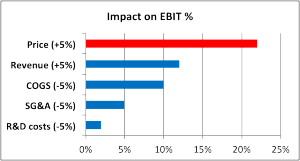For many companies pricing is viewed only as one of the 4 P’s in Marketing - i.e. Product, Place, Promotion and Price – relegating it to an operational decision. By thinking of pricing only in this light you short change the strategic impact and power it has as a tool to dramatically improve your company’s EBITDA. Pricing as a tool (see illustration below) has the greatest impact of all the Income statement tools at your disposal:

In today’s hyper-competitive and volatile global economy senior executives must look for every strategic edge that can help them move their company to meet the needs of their customers and in a way that is perceived as better value than the competition – and pricing is one tool that can deliver on this. Many companies we work with find that their “COST PLUS” approach to pricing coupled with fuzzy customer segmentation leaves them with only the perceived abiilty to “compete on price” and therefore give up profits. But this need not be the case.
To resolve this dilemna or missed opportunity companies need to get beyond COST PLUS pricing and shift to Value Based pricing which truly aligns your product and services with what customers actually want and will pay for.
Over the next weeks Scott Newton – our Italian Thinking Dimensions Global Partner and myself with be submitting a series of articles that will walk you through the benefits of value based pricing and give you practical steps you can take to evaluate your company’s pricing competency. The outcome is to help you shift your thinking on pricing from an operational to one that is a more valuable strategic decision making lever that delivers more EBITDA to your business.
As a simple starting point review the symptoms below that may point to the need your company should think about improving its pricing competency.
- Margin erosion is occurring
- No Commodity vs. Differentiation margin gap
- Loss of volume to competition
- Increasing inducements (i.e. rebates, discounted shipping, payment terms)
- No systematic way of pricing uniformly applied by sales force
- Reactionary pricing
- Pricing driven by cost
- Poor or gaps in customer segmentation
- One size fits all pricing
- Not having a common decision making process for pricing


